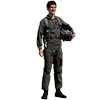H2FLY Achieve World’s First Piloted Liquid Hydrogen-Powered Electric Aircraft Flight

H2FLY HY4 First Piloted Flight of a Liquid Hydrogen-Powered Aircraft
Image of H2FLY HY4 inflight courtesy: H2FLY
H2FLY has announced what they say is the world's first piloted flight of a liquid hydrogen-powered electric aircraft.
In a release dated September 7, 2023, H2FLY says the test took place in Maribor, Slovenia, using their HY4 demonstrator aircraft. The only person aboard was the pilot, though the aircraft has two seats, and it appears to be derivative of the Pipistrel Taurus G4, a four seat airplane.
H2FLY is a German company that develops hydrogen fuel cell systems for aviation. The business was acquired in 2021 by Joby Aviation.
Liquid hydrogen-powered propulsion systems have been in active development in the drone or UAV sector for sometime, but flying examples of piloted aircraft are new. There is considerable interest in liquid hydrogen-powered aviation propulsion from major players such as Airbus and Embraer, but Boeing has so far focused primarly on so-called Synthetic Aviation Fuel (SAF).
Liquid hydrogen-powered human flight is not new. Liquid hydrogen, also known as cryogenic hydrogen, has powered human-rated spacecraft for decades, including the main engines on the US Space Shuttle program. The same hydrogen was used on the Shuttle to operate the non-propulsion system electrical power generating fuel cells for auxillary loads.
Hydrogen is of interest in aviation because if economic, regulatory and technical hurdles can be overcome, it offers the promise of better performance then pure battery-electric zero emission propulsion solutions. However, batteries do remain a smaller part of even hydrogen propulsion systems.
Broadly speaking, hydrogen can be stored three ways. As a metal, in a nickle-metal hydride for example, the ratio of volume to capacity is very attractive. However, the volume to system weight makes it unsuitable, short of a breakthrough technology, for aviation applications.
As a high pressure compressed gas, a method commonly seen atop transit buses in both hydrogen and natural gas powered vehicles. Typically, this method has attractive weight characteristics, but the volume required makes application in aviation less viable.
Finally, liquid cryogenic hydrogen offers a good balance between weight, capacity and system volume, but it does pose other challenges, including keeping stored fuel cold enough to remain in the tank instead of gassing off and being released by overpressure valves, and the energy needed to liquify the hydrogen.
In the case of the HY4, the company says the use of liquid hydrogen instead of compressed gaseous hydrogen has resulted in a range increase from 466 mi (750 km) to 932 mi (1500 km).
Based on the success of this stage of testing, H2FLY now plans to focus on commercial-appropriate systems. A key challenge they aim to solve is development of an aviation fuel cell stack that can function at altitudes as high as 27,000' to open market opportunities among regional airline aircraft and similar platforms.

Craig has decades of experience contributing to Flight International, Aviation Week, KCRW, NPR, and appearances on the Discovery, Military and History Channels.

 Welcome to AeroSpaceNews.com, the world's first
Welcome to AeroSpaceNews.com, the world's first